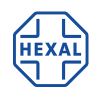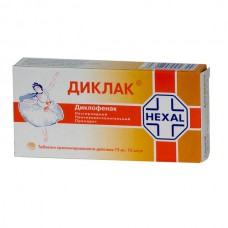Expiration date: 02/2026
Release form and composition:
Extended-release tablets of two layers (pink/white), round, flat, with smooth surface and facet on both sides.
Excipients: lactose monohydrate, methylhydroxypropylcellulose, cellulose microcrystalline, calcium hydrogen phosphate dihydrate, corn starch, sodium starch of glycolate, silica colloidal anhydrous, magnesium stearate, iron oxide red.10 PCs. - blisters (1) - packs of cardboard.
10 PCs. - blisters (2) - packs of cardboard.
10 PCs. - blisters (5) - packs of cardboard.
10 PCs. - blisters (10) - packs of cardboard.Pharmacological action:NSAID. Has a pronounced analgesic, anti-inflammatory and antipyretic activity. Non-selectively inhibits COX-1 and COX-2, violate metabolism arahidonova acid, reduces the amount of prostaglandins in inflammation. In rheumatic diseases anti-inflammatory and analgesic effect of diclofenac contributes to a significant decrease in severity of pain, morning stiffness, swelling of joints that improves a functional condition of the joint. In trauma, postoperative diclofenac reduces pain and inflammatory swelling.Pharmacokinetics:Vsasavayasi of the drug into the absorption of quick and full, the food slows the absorption rate for 1-2 hours and reduces Cmax by 2 times. In the case of taking the drug with food Cmax is achieved in an average of 5-6 hours Raspredeleniya of diclofenac to plasma proteins is more than 99% (the majority is bound to albumin). Vd - 550 ml/kg. Penetrates into synovial fluid. Cmax in synovial fluid is achieved in 2-4 hours later than in plasma. T1/2 of the synovial fluid is 3-6 h (the concentration of active substance in the synovial fluid after 4-6 hours after administration of the drug higher than in plasma, and remains higher for another 12 hours). The relationship of drug concentration in sinovialny liquid with clinical efficiency of the drug is not clear.Changes in the pharmacokinetics of diclofenac amid repeated introduction is not marked, not accumulates.Diclofenac is excreted in breast milk.??????????50% of the active substance is exposed to a metabolism at the first passage through the liver. Metabolism occurs in
the result of multiple or single-hydroxylation and conjugation with glucuronic acid. Metabolism of diclofenac involved isoenzyme CYP2C9. The pharmacological activity of metabolites below, than diclofenac.??????????1/2 of plasma - 2 h. Systemic clearance is 350 ml/min. 65% of the administered dose is excreted by the kidneys as metabolites by the kidneys, less than 1% in an unmodified form, the rest of the dose is excreted as metabolites in the bile.Pharmacokinetics in special clinical slucaju patients with severe renal insufficiency (KK less 10 ml/min) increases the excretion of metabolites in bile, with increase of their concentration in blood is not observed.In patients with chronic hepatitis or compensated cirrhosis pharmacokinetic parameters of diclofenac are not changed.Indications:- diseases of the musculoskeletal system (rheumatoid arthritis, psoriatic, juvenile chronic arthritis, ankylosing spondylitis gouty arthritis, rheumatic soft tissue osteoarthritis of peripheral joints and spine, including with radicular syndrome, tenosynovitis, bursitis)- pain syndrome weak or moderate intensity: neuralgia, myalgia, sciatica, post traumatic pain syndrome accompanied by inflammation, postoperative pain, headache, migraine, algomenorrhea, adnexitis, proctitis, dental pain in the complex therapy of infectious-inflammatory diseases of ear, throat, nose with marked pain syndrome (pharyngitis, tonsillitis, otitis media)- febrile syndrome.Dosing regimen:the Drug is administered orally, without chewing, drinking a small amount of water, usually during or after a meal.Prescribed 75 mg (1 tab.) 1-2 times/day or 150 mg (1 tab.) 1 time/day. The maximum daily dose - 150 mg. Side effects:From digestive system: gt1% - abdominal pain, sensation of bloating, diarrhea, nausea, constipation, flatulence, increase in liver enzymes, peptic ulcer with possible complications (bleeding, perforation), gastrointestinal bleeding t1% - vomiting, jaundice, melena, appearance of blood in the stool, lesions of the esophagus, aphthous stomatitis, dry mouth and mucous membranes, hepatitis (perhaps for fulminant), hepatic necrosis, cirrhosis, hepatorenal syndrome, appetite change, pancreatitis, holetsistopankreatit, colitis.CNS: gt1% - headache, dizziness t1% - sleep disturbance, drowsiness, depression, irritability, aseptic meningitis (more often in the patients with SLE and other systemic diseases of connective tissue), convulsions, weakness, disorientation, nightmares, feeling of fear.From the senses: gt1% - tinnitus t1% - blurred vision, diplopia, taste disturbance, and reversible or irreversible hearing loss, scotoma.Dermatological reactions: gt1 % - skin itching, skin rash t1% - alopecia, urticaria, eczema, toxic dermatitis, photosensitivity, petechial hemorrhages.From the urinary system: gt1 % fluid retention t1% - nephrotic syndrome, proteinuria, oliguria, hematuria, interstitial nephritis, papillary necrosis, acute renal failure, azotemia.With the hematopoietic system: t1% - anemia (including hemolytic and aplastic anemia), leukopenia, thrombocytopenia, eosinophilia, agranulocytosis, thrombocytopenic purpura, respiratory system: t1% - cough, bronchospasm, laryngeal edema, pneumonitis.From the side of cardiovascular system: t1% - increased blood pressure, congestive heart failure, arrythmia, pain in the chest.Allergic reactions: t1% - anaphylactoid reactions, anaphylactic shock (usually develops rapidly), swelling of the lips and tongue, allergic vasculitis, exudative erythema multiforme, including the Stevens-Johnson syndrome, toxic epidermal necrolysis (Lyell's syndrome).Other: t1% - worsening of infectious processes (development of necrotizing fasciitis).Contraindications: erosive-ulcerative lesions of gastrointestinal tract (in acute phase)- bleeding from the gastrointestinal tract is aspirin asthma - disorders of blood - disorders of hemostasis (including hemophilia)- child and adolescence to 18 years - pregnancy - lactation (breastfeeding)- hypersensitivity to drug hypersensitivity to other NSAIDs.With caution the drug should be used for anemia, bronchial asthma, congestive heart failure, arterial hypertension, otechny syndrome in hepatic or renal failure, alcoholism, inflammatory bowel diseases, erosive and ulcerative lesions of the gastrointestinal tract without exacerbation, diabetes, condition after extensive surgery induced porphyria, elderly patients, with diverticulitis, systemic diseases of connective tissue.Pregnancy and lactation:the Drug is contraindicated during pregnancy and lactation (breastfeeding).Special instructions:during treatment should conduct systematic monitoring picture peripheral blood, liver, kidneys, examination of feces for presence of blood.While taking the drug should exclude alcohol.Effects on ability to drive vehicles and management mechaniziation taking the drug should refrain from activities require high concentration and rapid psychomotor reactions.Overdose: Symptoms: vomiting, dizziness, headache, shortness of breath, dizziness, children - myoclonic seizures, nausea, abdominal pain, bleeding, impaired liver and kidneys.Treatment: gastric lavage, administration of activated charcoal, symptomatic therapy, forced diuresis. Hemodialysis is ineffective.Drug interactions:Increases concentration in plasma digoxin, methotrexate, lithium preparations and cyclosporine.Reduces effect of diuretics, against kalisberegath dioretikov increases risk giperkaliemii against the background of anticoagulants, thrombolytic drugs (alteplase, streptokinase, urokinase) - the risk of bleeding (often from the gastrointestinal tract).Reduces the effects of hypotensive and hypnotic drugs.Increases the likelihood of side effects of other NSAIDs and corticosteroids (bleeding from the gastrointestinal tract), toxicity of methotrexate and nephrotoxicity of cyclosporine.Acetylsalicylic acid reduces the concentration of diclofenac in the blood.Concurrent use of paracetamol increases the risk of nephrotoxic effects of diclofenac.Reduces the gipoglikemicakih funds.Cefamandole, cefoperazone, cefotetan, valproic acid and plicamycin increase the frequency of gipoprotrombinemii.Cyclosporine and preparations gold strengthen the effect of diclofenac on prostaglandin synthesis in the kidneys, which increases the nephrotoxicity.Coadministration with ethanol, colchicine, corticotropin, and drugs St. John's wort increases the risk of bleeding from the gastrointestinal tract.Diclofenac enhances the effect of drugs that cause photosensitivity.Drugs that block tubular secretion, increase in plasma concentration of diclofenac, thereby increasing its toxicity.Terms and conditions of storage: List B. The drug should be stored at temperature not exceeding 25°C. shelf Life - 3 years.
Diclac
(Diclofenac)
75mg
10
tablets
long
- Brand: Hexal


